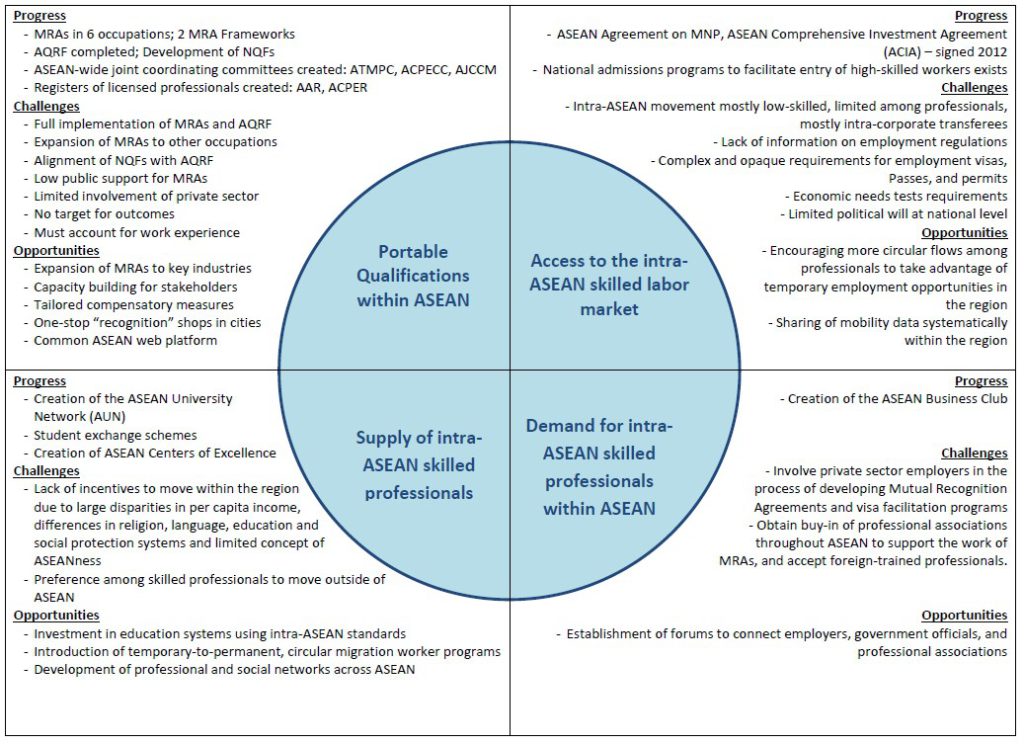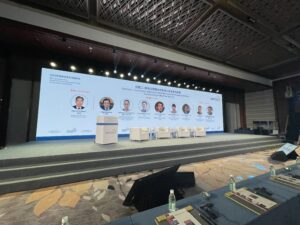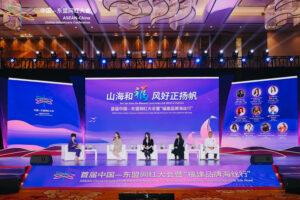Introduction
Skills mobility is central to the realization of the AEC vision of creating of a single market and production base, where there is a free flow of goods, services, investments, capital, and skilled labor. Under the purview of the ASEAN Economic Community (AEC), ASEAN leaders would like to see not necessarily free labor mobility, but rather freer movement of professional groups or skilled labor. Although the state of intra-regional migration in ASEAN is rising and expanding as its economies become more integrated, for the most part, the intra-ASEAN labor migration of low and medium skilled workers is higher compared to the movement of skilled labor. The movement of high skilled workers in ASEAN though had increased already in the past decade and is expected to increase further, is still truncated.
For instance, since 1990, the stocks of intra-ASEAN migrants have risen substantially. Intra-ASEAN migrants increased from 1.5 million to 6.5 million between 1990 and 2014. Over the same period, the share of ASEAN’s total migrant stock climbed from 47.8% to 68%. A corresponding rise is also observed among ASEAN national living abroad – where the intra-ASEAN shares rose from 20.3 to 34.6 percent over the same period (ADB/ILO: 2014). In key destination countries in ASEAN more than half of the migrant stock comes from other ASEAN member states. For Singapore 52.9%; for Malaysia 61.2%; and for Thailand 96.2% (ADB/ILO: 2014). Similarly the proportion of migrants heading for other ASEAN member states has increased for the major countries of origin. Since 1990, the intra-ASEAN migration from Myanmar, Lao PDR, and Cambodia has risen in each case by around 40% points in terms of their total nationals abroad (ADB/ILO: 2014). For Vietnam and the Philippines however, intra-ASEAN migration in 1990 accounted for only 7% of their total nationals abroad and has since declined further, the main destinations being in the Gulf Arab States, East Asia, Europe, and North America (ADB/ILO: 2014. ASEAN has 3 main destinations, – Malaysia, Singapore and Thailand, together they account for approximately 90% of the region’s total migrants, and 97% of intra-ASEAN migrants. In all three, the migrant stock is dominated by a single country of origin; in Singapore, 45% are from Malaysia, in Malaysia, 42.6 are from Indonesia; and in Thailand, 50.8% are from Myanmar (ADB/ILO: 2014).
However, in the midst of these intra-ASEAN labor mobility developments, one recurrent reality is the very the fact that the largest chunk of the migrant stocks consists of low and medium skilled workers and very little could be attributed to high skilled labor movement. Despite the commitment towards an integrated regional economy where free flow of skilled labor is a key element, progress on liberalizing the movement of natural persons remains relatively low. Out of the 8 occupations currently covered by MRAs, the seven accounts jointly for only between 0.3% and 1.4% of total employment in ASEAN member states. The 8th MRA refers to tourism professionals for which there is no single occupational category by which to calculate corresponding share. They thus represent a negligible fraction of the total jobs held in ASEAN (ADB/ILO: 2014).
With this picture, and given that ASEAN has a combined population of over 622 million of which 50% of this is under the age of 30, making up a large portion of both the current and future workforce, which gives ASEAN the leverage to enjoy demographic dividends (the growth of the labor force is still higher than the growth of the total population) to capitalize on, it is imperative to examine the progress, key challenges, and opportunities of the 4 important elements (i.e. portable qualifications within ASEAN; supply of intra-SEAN skilled professionals; access to the intra-ASEAN skilled labor market; and the demand for intra-ASEAN skilled professionals within ASEAN) in achieving skills mobility to determine if the future of skilled labor mobility is ASEAN is optimistic or bleak.

Conclusion
Talent mobility has increased across time and space in the advent of globalization, the spread of new information technology, lower transportation costs, and most of all, because of regional economic integration and arrangements. It has important development effects both on the sending nations and receiving countries, regionally and globally. Given its economic worth that comes from its various uses including but not limited to productive resource for current production, or source of wealth creation, a source of knowledge, provider of social services, or cultural work, talent mobility gains currency as a vital policy issue that governments need to consider.
Concurrently, as ASEAN becomes more and more a single market and a regional production center driven by skills, innovation, and creativity, the movement of skilled labor becomes the more imperative.
With a growing market of more than 625 million consumers and a combined gross domestic product (GDP) of nearly USD $ 3 trillion, ASEAN will gain much from the movement of skilled labor. In its absence, business will not prosper, industries will not gain competitiveness, individuals will not be able to capitalize on a more increased productivity and per capita income, and most of all, in the absence of skills mobility, foreign direct investments will be scarce. All these taken together will not be good to ASEAN vis-à-vis a skills-driven global economy.
Furthermore, if ASEAN skilled labor will not be able to move intra-regionally, this will result to professionals being underemployed or unemployed. Hence, highly-skilled people are mobile and are always looking for opportunities the likelihood of them moving to third countries like the US, Canada, Australia and EU countries is higher. This scenario will constitute a huge and damaging brain drain for ASEAN.
In this regard, it is therefore imperative and crucial for ASEAN policy makers to ensure that the 4 elements in achieving skills mobility are taken seriously and that ASEAN governments cooperate in addressing the key challenges and explore the opportunities that these pillars present.
References:
International Organization for Migration. (2005). World Migration 2005: Cost and Benefits of International Migration.
Soliman, A. 2006. The International Mobility of Talent and its Impact on Global Development: An Overview. United Nations. Santiago, Chile



